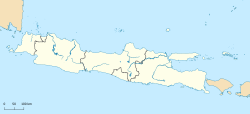|
Parung
Parung (Sundanese:ᮕᮛᮥᮀ) is a town and an administrative district (kecamatan) in Indonesia that is located near the southwestern suburb of South Jakarta but officially still within the area of the Bogor Regency. Parung District covers an area of 25.86 km2, and had a population of 112,529 at the 2010 Census[2] and 123,078 at the 2020 Census;[3] the official estimate as at mid 2023 was 128,905 - coprising 65,568 males and 63,337 females.[1] Those who travel from Jakarta to Bogor through the western alternative road will have to pass through Parung. It has a traditional market called Pasar Parung as its commercial centre. The market is situated exactly on both sides of the main road which inevitably causes daily traffic congestion. Pasar Parung is marked by a huge tree which is called Pohon Jubleg by the locals. Jubleg means 'idle' and 'not going anywhere' in according to locals.[4] Locals often attributed mystical elements to the tree because of its old age.[5] Administrative divisionsThe administrative centre of the district is at the town of Warujaya, and the district is sub-divided into nine villages (desa), all sharing the postcode of 16330, as listed below with their areas and populations as at mid 2023.[1]
EconomyParung is famous locally for producing durian called durian parung. It is however becomes particularly rare to find such durian in Parung itself.[6][7] Parung is also famous for its fish cultivation, particularly ornamental fish. Pasar Parung, which serve as Parung's commercial center, is widely acknowledged as the biggest ornamental fish market in Indonesia,[8] and maybe even in Southeast Asia.[9] CulturesParung District is close to the border with the cities of South Tangerang and Depok which are the centres of Betawi culture, so that there is a mix of Betawi culture with local Sundanese culture in the Parung area. The mixing of cultures in the Parung District causes the typical arts of the district to also vary. There are religious arts such as marawis, tambourines, then kelaran parade arts and cucurak which have existed in Parung District since ancient times and are still inherent in Parung. The Sundanese language is also still used by the community in several villages in the Parung District which borders Ciseeng District and Kemang district, but some still use Betawi language in the area bordering Depok and South Tangerang. The language used in Parung is also a mixture of cultures between the nine villages in Parung District.[10] References
External links |
||||||||||||||||||||||||||||||||||||||||||||||||||||||||||||||||||||||||||||||||||||||||||



